|
Wiltshire is an important stronghold for the Duke of Burgundy, the UK’s fastest declining butterfly. Although many of the butterfly’s populations are small and medium sized those in southwest Wiltshire are faring better than elsewhere as there are still connections between populations. The Shaston Ridge (the ridge running south of the A30 between near Donhead St Andrew and near Burcombe) is one of its strongholds. However, our knowledge of its distribution and population sizes there is far from complete!
We have records from all along the ridge, but they have not been collected in a consistent manner. Nor have sites with potential, or all locations which previously held the species been visited recently. We’d like to recruit a team of volunteers to help undertake timed counts for Duke of Burgundy. This is a simple method of recording a single species and involves walking a set area and counting the number of Duke of Burgundy butterflies seen. All training will be provided, no experience is necessary just and interest in conserving a charming little butterfly speciality of our local area. The more recorders we can recruit, the more sites we will be able to cover with this consistent recording system. Would you like to be involved? The survey will take place between Mid-May and Mid-June and we’ll run some training before the flight season starts. Sites will be split and allocated across the team of volunteers, and I will be able provide ongoing support to build-up skills and share information about individual sites. If you would like to take part, please contact me in the first instance via the Contact form and I will be in touch. Andrew Graham Andrew Graham has given us a richly detailed recounting of places to visit locally. On the new Local wildlife sites page, reached via the Resources tab on the menu and passing through Wildlife identification and recording, you will find separate sections on local woodlands, water habitats, grasslands and other places of interest.
Debbie Carter has given us some valuable assistance in listing out the wildflowers you may be able to spot locally across four habitat types (chalk downland, hay meadows, woodland and wetland). With Ordnance Survey grid references, this is an impressive guide, all beautifully illustrated with the wildflower photographs taken by Andrew Carter.
Please refer to the Resources part of the website to locate the growing number of Local Wildlife pages we're adding to the Wildlife identification and recording section. Inés has shared a fascinating insight into the use of an additional freezer kept at her home, with the purpose of aiding scientific investigation into the health of wildlife.
"I have recently been updating the inventory of my corpse freezer. This sounds a bit gory but I would like to explain that it is all for a good reason. Last year, a chest freezer became available locally on Freecycle.org and I decided to grab the opportunity and set up a freezer that would act as a local hub for the temporary storage of dead animal samples that can contribute to wildlife conservation and research. The current contents of my corpse freezer include a dead slow worm that I found on the road (but not flattened) a couple of weekends ago. I reported it on the website Garden Wildlife Health and on the Monday after, I received a call from ZSL vets, very interested in doing a post-mortem on my slow worm. I am just waiting for their pre-paid envelope to send it back to them. One of our members (thanks, Juney!) found a sparrowhawk in their garden, sadly deceased after having crashed against their window. This one is also in my freezer waiting for another dead bird of prey to be found, to fill the pre-paid box that I have from the (Predatory Bird Monitoring Scheme) before sending it. A few months ago I sent them two owls and when they finish their analysis they will let us know the results. Birds of prey often have symptoms of secondary poisoning or their body tissues contain concerning levels of toxic products, all due to the ingestion of prey items which have been poisoned (e.g., rat poison, slug pellets...). I also have a couple of otters that died in road collisions with cars, which I will deliver to the Cardiff Otter Project this summer. They will ascertain if the otters have any underlying health condition, their sex, their age, their breeding condition, and possibly do some DNA analysis too. The good news from this project is that populations of otters are slowly recovering nationwide from previous minimum numbers. However, their populations are not genetically diverse and are therefore vulnerable. In addition, background river pollution is also detectable in otter body tissues. Past contents of my corpse freezer include faecal/swab samples from mustelids that were sent to Nottingham University for research on COVID-19 transmission between humans and wild mammals (none tested positive) and bats that were sent to Defra for rabies testing (also negative). Other animals that are not required for any post-mortem research project, I may skeletonise for archaeological reference collections. It is sad to find dead animals, particularly when they have died because of us (humans). While some dead animals may be suitable to be left in the wild to serve as food for scavengers, sometimes it is better to remove the animal from the environment to prevent the spread of disease or contribute to the conservation of the species. The results from many of these analyses projects provide information on a wide range of elements that are useful for conservation research and have the potential to inform on policy (such as regulating the contents of pest-control products). If you are potentially interested in helping with this research, please have a look at our website section and scroll down to "Dead wildlife" (https://www.tisburynaturalhistory.com/recording.html) to find out what animals are interesting for sampling. Don't hesitate to get in touch if you encounter any animal samples that may be useful, the "corpse freezer" has some space!" 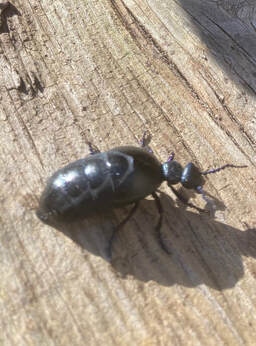 The committee have been enjoying a conflab on beetles. Dick found an interesting looking beetle near his house in bright sunshine, about 30mm long with a distinctive scaly pattern on its back and he sent an email around for suggestions on its species. And then did manage to track it down himself on the internet as the meloe proscerabaeus (Black Oil Beetle). Peter then passed on Tracy Adams’ nugget which she’d given to the Nadder Valley Cluster Group that “Black Oil Beetles have a fascinating but slightly gruesome life cycle which involves the larvae or the bizarrely named 'triungulins'. They climb up onto flowers & hitch a ride on the back of a solitary mining bee who take them into the nest & where they eat all the bee's eggs & pollen & nectar stores. The larvae develop in the burrows & emerge in spring as an oil beetle ready to mate & start the cycle again. They are a declining species so it is important to submit any records.” 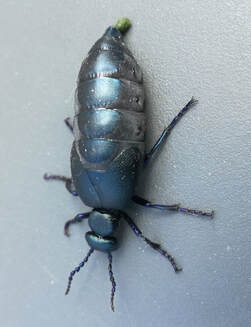 Andrew remarked “I get Oil Beetles on the wild bank in my garden and have been advised that you need to get a good look at the shape of the thorax to separate out the Black from the Violet Oil Beetle. I can't make the shape out from the pic and though there is certainly some violet there and the antennae are a bit bent both are features of both a Violet and a Black Oil Beetle. The Violets have a western distribution so it could be. I haven't seen any in my garden yet this year but saw one walking down Weaveland Road on Monday - well I was walking down the road, the beetle was walking down the pavement...” Andrew has added a photo of his own and finds it hard to decide whether his was a Black or a Violet. A green poo pellet graced the photo too, so we have further natural history findings to pass on! Andrew has also shared a useful factsheet link from BugLife about Oil Beetles.
This cosy nest was photographed by Andrew Graham and shown to Inés and Debbie who concluded it belonged to a Wood mouse. Having the ruler for scale and its location in a wood pile, helped to identify the animal who'd made it. We're always happy to assist with any identification queries, so if you want to use the contact form first of all, we'll send you the email address for submission.
|
Photo: Avocets (Izzy Fry)
The headers display photos taken by our members. Do get in touch via the Contact Form if you'd like to submit a photo for selection.
Archives
May 2024
Categories
All
|
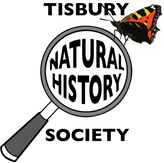
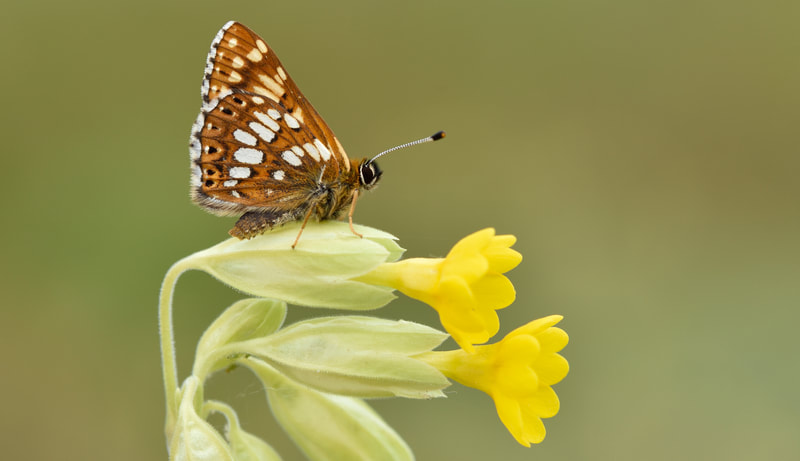
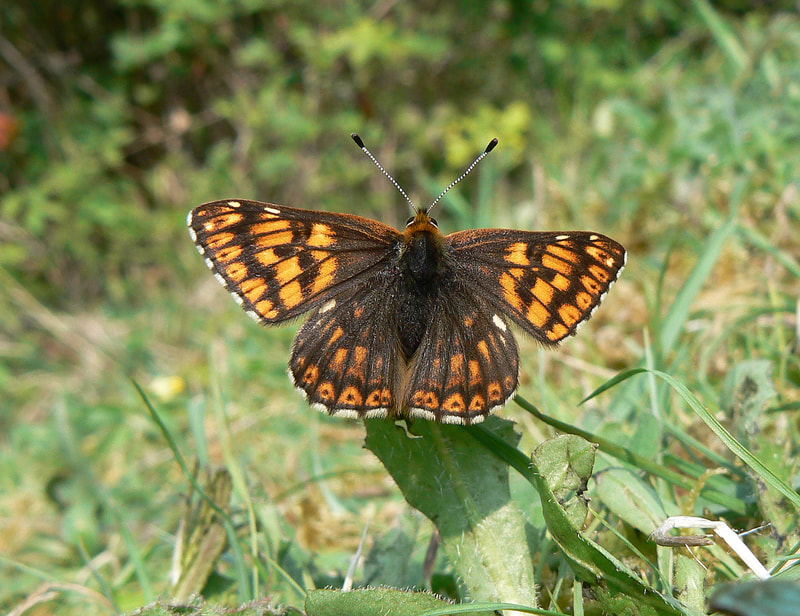
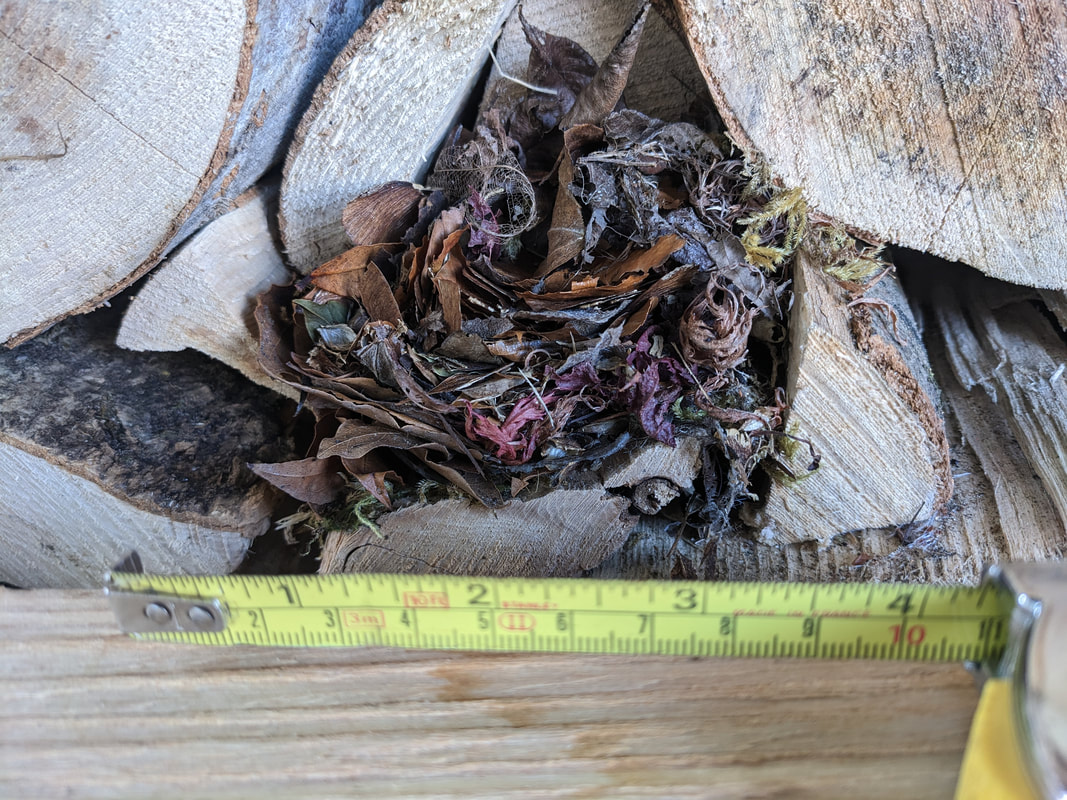
 RSS Feed
RSS Feed